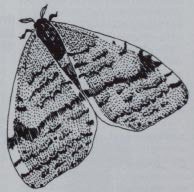The adult of this native pest is often called the hunter's moth. Look for them during hunting season when they emerge from their cocoons in October or November, long after leaves have fallen and sometimes when there is snow on the ground.
The females are only 1/4 inch long and are wingless. They can be seen crawling up tree trunks while the much more obvious males fly around at low altitudes, searching for mates. The male moth has a wingspan of about an inch and his wings have gray or brown bands on a tan background. After mating, the females lay pale green eggs under lichens or in bark crevices. The eggs soon turn bright orange and they hatch the following spring, about when buds open. Maple and beech leaves are their favorite foods in the east, but the larvae have been collected on at least 14 other hardwood species and in western Canada they prefer aspen and willow.
The larvae feed for five to seven weeks and damage reaches a peak near the end of June when they reach their full length of about 3/4 inch. Then they drop to the ground and spin a golden to dark brown pupa, disguised with a coating made of bits of humus and sand.
Each larva consumes a total of about two maple leaves, but they a nack many more, and whole trees will have seriously tattered leaves during a Bruce spanworm outbreak. Fortunately outbreaks are few, far between and short lived. It is believed that parasitic wasps play a role in ending these sieges and several bird species eat the larvae. The most important natural control agent, however, appears to be a disease caused by a virus.
Insecticides are rarely needed. Heavily defoliated hardwoods will usually produce a new crop of leaves later in the season and are unlikely to be killed by Bruce spanworms. If a large number of moths are seen around valuable shade trees, sticky collars will stop egg-bearing females in their tracks.
Bruce spanworms are among the many caterpillars which are commonly called inchworms. They are in the family Geometridae, which means "earth measurer." The caterpillars have a long central section without legs and when they bring their rear legs up to meet the front ones, the mid-section momentarily forms a loop, giving them yet another name, loopers. Then the front legs are lifted and moved ahead, and the voracious head is dropped on new pastures.
The last outbreak in Vermont began in 1981 and some damage was noted this past spring, possibly signaling another upturn in spanworm numbers.


